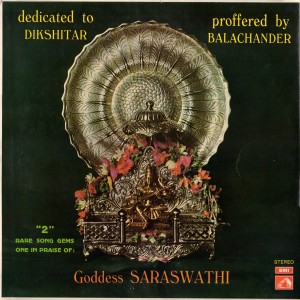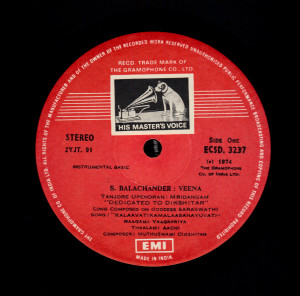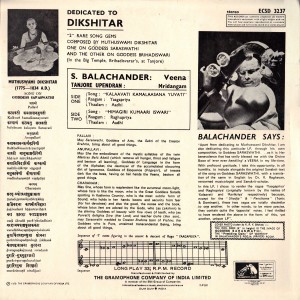[simple-author-box]
Introduction:
Very many ragas were mere theoretical constructs of Muddu Venkatamakhin when he tabulated his rAgAnga scheme available us today as the Anubandha to the Caturdandi Prakashika. It is undeniable that they were given life, flesh and blood only by the composer nonpareil Muthusvami Dikshitar. One such raga is kalAvatI, the 31st rAgAngam or the head of the 31st mela/clan in the raga scheme. Many of these derived ragas were anointed as the clan heads/rAgAngAs such as Tarangini, Ragacudamani and whole bunch of prati madhyama ragas. To provide a formal musical expression for these still born rAgAngas , Dikshitar almost as a rule created short compositions with just a pallavi, anupallavi and a cittasvara/muktayi svara section for these rAgAngAs. Perhaps he feared that since they were neither ghana or rakti ragas, a huge monolithic kriti construct for these so called svara based ragas would be burdensome and repetitive. However for a select few of these rAgangAs, for reasons known to himself, Dikshitar created a full-suite kriti with pallavi, anupallavi and lengthy multiple tala avarta caranam with or without the cittasvara section, for example Vamsavathi, Phendyuti, Viravasanta, Tarangini and off course Kalavati- the subject matter raga for this blog post.
kalAvatI as a raga according to Prof S R Janakiraman is exclusive to the Sangita Sampradaya Pradarshini, as the raga is documented and illustrated for the first time in musical history, only in that treatise. The raga has no connection with the raga of Tyagaraja’s two compositions – ‘ennadu juthano’ and ‘okapari’ – both being composed in a melody being a janya under 16th mela Cakravaka. The said compositions have been given the same raga name of Kalavati on the authority of Govinda’s Sangraha Cudamani. This blog post has nothing to do with this raga Kalavati under the 16th mela, (which has an entirely different svarupa) and is only about the raganga representing mela 31, Kalavati as handled by Dikshitar. It needs to be noted here that Tyagaraja has no composition under mela 31 raganga Kalavati or its heptatonic equivalent Yagapriya or any derivative raga therefrom. Neither do we have any recorded composition by any other composer of repute.
Thus for all practical purposes this melody is a eka kriti raga with Muthusvami Dikshitar’s ‘ kalAvatI kamalAsanayuvatI’ extolling Goddess Sarasvati, being the sole kriti exemplar ( barring a couple of other ones found in the SSP namely the gitam, tanam, sancari and a couple of ragamalikas where the raga finds a place).
On the occasion of Sarasvathi Pooja today being celebrated as a part of Navaratri, this raga and DIkshitar’s composition on the Goddess of Learning is presented through this blog post as obeisance to Her.
Over to the raga and the composition!
BRIEF BACKGROUND:
As pointed out earlier, Muddu Venkatamakhin’s raga compendium, Raga Lakshanam/Anubandha to the Caturdandi Prakashika, dateable to 1750 or thereabouts is the first musical text mentioning this melody. On that strength the SSP documents this raga as the implementation of the 31st mela or as the rAgAnga therefrom. The raga sports two vivadi note combinations (R3G3 and D1N1) both in the purvanga and uttaranga sections. As we have seen in an earlier blog post the raga architecture in the case of vivadhi notes has two important components :
- Taking into account the vocal renditional felicity & harmonics the vivadhi notes are made devious in the arohana/avarohana. Thus we see the R3G3 (shatsruti rishabha and antara gandhara) combinaton can be lineal in the ascent but has to be devious/vakra in the descent – that is they are implemented as PMG3MR3S or simple PM1R3S. Similarly for the D1N1 combination we do not see a lineal PD1N1S in the ascent – the suddha nishada is avoided or made vakra in the ascent as PD1N1DPS or PDPS or PDS or PDDS while in the descent it can be lineal as SN1D1P as the transition from N1 to D1 can be facile in the descent.
- The dissonant notes are necessarily ornamented with a gamaka for example by the the jaaru/glide in S\N1D1P or D1/N1D1P while R3 is usually given emphasis through the kampita gamaka.
Kalavati is no exception to this rule. And so predictably Subbarama Dikshitar in perfect accordance to Muddu Venkatamakhin’s lakshana sloka provides the nominal arohana/avarohana murcchana as under:
Arohana : S R3 G3 M1 P D1 N1 D 1 P S
Avarohana: S N1 D1 P M1 R3 G3 M1 R3 S
Subbarama Dikshitar adds that the two prayogas which makes this raga shine are PDNDP and SNDP with emphasis on sadja and nishadha in the later prayoga. The SSP provides us with the following exemplar compositions.
- Lakshya gitam of Muddu venkatamkhin in Jhampa tala
- Two sets of tanam of Muddu Venkatamakhin
- Muthusvami Dikshitar’s adi tala kriti ‘kalAvatI kamalAsanayuvatI’
- Subbarama Dikshitar’s sancari in matya tAla
In the anubandha the following two ragamalikas are found both being composed by Subbarama Dikshitar which sport this raga as one of it anga.
- 72 ragAnga rAgamAlika- I Kanakambari in which the 31st section is in kalavati beginning ‘ gAnalola’
- ‘kAmincina kalAvatI’ in the ragas kalAvatI, srI, todI, Manohari, Kannada, Sankarabharanam, purnacandrika, varali, sama, kedaragaula, khamas, maruva , kapi, Sahana, mohanam, vasanta as anuloma svara sahitya ( 16 ragas) sections and saveri kuranji, saranga, Kalyani, kambhoji, pantuvarali, arabhi, ahiri, gaula, nata, Yamuna, padi, nayaki, Lalitha, paras and Gauri( 16 ragas) as the viloma svara sahitya sections. Here Kalavati raga section is the pallavi refrain which is rendered once at the beginning and one at the end. This mammoth composition in tisra eka tala is on the Maharaja of Vijayanagaram .
THE COMPOSITION:
The kriti has been constructed in true Dikshitar style and the key points are summarized below.
- The kriti has the pallavi, anupallavi and the carana together with the final madhyamakalasahitya section.
- The standard colophon of Dikshitar ‘ guruguha’ is found as in ‘purAri-guruguha-hrudaya-ranjanIm’. The raga names is conspicuously embedded right at the very beginning glorifying Goddess Sarasvati as perhaps the moon or embodiment of arts.
- Given that the raga is svara oriented/scalar raga (and is certainly not a ghana or rakti raga type) , we do not find too much of gamaka embellishments in Subbarama Dikshitar’s notation of this composition.
- While the composition is in praise of the Goddess of learning one is unable to specifically place the location or shrine to which can be attributed, like how very many of Dikshitar’s kritis could be. There is one reference though which could be a potential pointer. In the beginning of the carana he says ‘kAsmIravihArA’. Dikshitar was an itinerant musician and one therefore could conjecture his visit to Kashmir. We do not have any more evidence beyond that. See Foot Note 1.
- The kriti conforms to prAsA concordance as one can expect and it extolls the Goddess of Learning in such terms including ‘ murAri snushAkA’
DISCOGRAPHY:
We will conclude this blog post with the analysis of the recordings of this composition. The earliest recorded performance of this raga and the exemplar composition is arguably by Veena Vidvan S Balachandar. Given that we have a recorded version also by his brother Sangita Kala Acharya S Rajam also of this composition, it is likely that the version was sourced from Ambi Dikshitar, from whom Sri S Rajam had learnt quite a few Dikshitar compositions during the brief stay of Ambi Dikshitar in Madras circa 1930.
Here is the recording of Vidvan’s Balachandar’s rendering. See Foot note 2.
And not unsurprisingly the printed sleeves & cover for this gramophone record, represents the raga of this composition wrongly as ‘Yagapriya’, the heptatonic equivalent of Kalavati. Sri Balachandar’s raga exposition as well as his svara kalpana follows the Yagapriya – complete lineal heptatonic route.
This kriti rendering tracks to Sri S Rajam’ rendering, which can be heard on Youtube here.
In comparison to the SSP notation, one can notice that these renderings deviate in quite a few places. And its indeed an element of puzzle as this oral version traceable back to Subbarama Dikshitar through Ambi Dikshitar, his son does not compare well with the written notation as provided by Subbarama Dikshitar himself in the SSP, making us wonder as to who effected the change in the pAtham. In passing we can notice that the rendering of many contemporaneous vidvans would show that they learnt it either directly from S Rajam or from this recording.
Presented next is the lecture demonstration of Prof S R Janakiraman,(Prof SRJ) which is much like a lodestar for understanding the raga. This is an excerpt from a Music Academy lecture demonstration from the year 2005
Prof SRJ with great verve and passion, in this gem of an exposition, takes us on a tour, elaborating the raison d’etre for this raga being the subject matter of his demonstration, how it differs from Yagapriya, the logic of the vivadi notes being vakra, the need to sing the composition with absolute fidelity to the notation and lastly if not the least an exposition of the contours of the raga and his interpretation of the Dikshitar composition.
Laced with pungent humor Prof S R Janakiraman laments how this composition has been recast as if it was a Tyagaraja composition, speeded up and dealt with in a casual manner. It goes without saying that this kriti too has to be rendered in the majestic cauka kala pace, typical of Dikshitar’s compositions without accelerating the tempo.
Presented next is a brief excerpt of the rendering of the composition by Sangita Kalandhi Vedavalli from her commercial release “Sarada Stuti Manjari”. See Footnote 3.
Presented next is a brief excerpt of the rendering of the composition by Vidushi Amrutha Murali from her commercial release “Sarvashree” released by Charsur. See Foot note 4.
Besides the above, we do have commercial recordings of Dikshitar’s composition by Vidusis Sowmya, and Vijayalakshmi Subramaniam in the public domain. It would not be out of place to point out very many of these renderings have the madhyama kala section “purAri guruguha hrudaya ranjanI” rendered in tara stayi whereas the section is expressly notated by Subbarama Dikshitar in mandhara sthAyi which Prof S R Janakiraman pointedly renders with fidelity to the SSP.
Also available is a privately recorded ragam-tanam-pallavi in three ragas, all of which bear the name of Kalavati under their respective sampradayas/genre – Dikshitar’s Kalavati, Tyagaraja’s Kalavati and Hindustani Kalavati akin to our Valaji. This is by Vidvan Sherthalai Ranganatha Sarma.
There are no extant recordings of both the Subbarama Dikshitar’s ragamalikas in the public domain as they are practically extinct on the concert circuit.
I present another interpretation of this composition with straighter notes, providing food for thought:
PERSONAL REFLECTIONS:
Given the notation as seen in the SSP and the available renderings I had always felt that the articulation of the PD1N1D and SN1D1P should be aurally even more nuanced and particularly the transition from D1N1D1 should be articulated even better. Given this, I have ventured to render it myself, the recording of which is below. One very good, close to the SSP notation, rendering which I have heard is of Vidvan T M Krishna’s, when he sang it soulfully in his Narada Gana Sabha 2014 Season concert.
In the context of interpreting the SSP notation, a personal view point needs articulation. Subbarama Dikshitar has notated the songs in the SSP based on his tutelage under Balasvami Dikshitar and perhaps other prime disciples of Muthusvami Dikshitar himself. Transcribing them into the SRGM notation along with his invented notation for the gamakas, Subbarama Dikshitar was attempting to distil the musical structure as much as he could. I don’t think it is humanly possible to “absolutely” transcribe with 100% fidelity, a rendering of a Carnatic composition into notation. And equally remote is a 100% high fidelity reproduction of the same by rendering the composition back from notation. This process cannot be loss-less by any stretch of imagination.
The task of converting a musical idea/notes into a 100% hi-fidelity lossless notation in written form is a semiotic impossibility. The un-notatables, the micro tones, grace notes and subtle nuancing of harmonics of the individual notes of our music are all too complex to be reduced to notation using a dozen signs. It is my earnest view that such a recreation, by reading the notation ‘verbatim’ would defeat the very purpose of the exercise as the output is more possibly a dull copy of the original. A more purposive or what I term as a creative interpretation or approach would be to ‘constructively’ interpret the notation taking the notation of Subbarama Dikshitar as road signs or as the means rather than the end in itself. Additionally versions from oral traditions and other inputs such as the mode of rendering the raga in authentic practice etc can be used to triangulate and optimize the interpretation.
With this view, I have as much as possible tried to keep to the spirit of the notation, attempting to interpret the notation in the Carnatic idiom to derive for myself the pen picture of this composition, as close as possible to how perhaps Dikshitar might have created in the original. In only the final avarta of the pallavi do I use PDSNDP. Otherwise I stick to PDNDP or SNDP as applicable.
Personally this composition for me represents a creation of the highest aesthetic order. The turns and bends, the almost lavish baroque use of the vivadhi combinations and the almost perfect blending of the sahitya with the notes makes this a perfect example of what the French would call the chef-d’-oeuvre !
REFERENCES:
- Subbarama Dikshitar(1904) -Sangeeta Sampradaya Pradarshini with its Tamil translation published by the Madras Music Academy
- Prof. S R Janakiraman(1996) – Raga Lakshanangal(Tamil)
- JMA (2005)- LXXVI- Page 160- Proceedings of 3rd Jan 2005 published by the Madras Music Academy
- Vidya Shankar(2005) – JMA 2005 LXXVI – Gamaka Notation in Sangita Sampradaya Pradarshini – pp 191-206
FOOTNOTE:
- The Sarasvathi Devi or Sharada of Kashmir has very many interesting mythologies and legends associated with it. It could be that Dikshitar was perhaps alluding to Sharadha Devi at the temple in Kishenganj which is today in Pakistan Occupied Kashmir. We have a similar point to ponder in the case of another Goddess Sarasvati related kriti namely the Sharavati raga kriti ‘Sharavathi tata vasini’. One cannot confirm the exact temple or place so signified in the composition which is the banks of the river Sharavathi. In so far as this Kalavati raga kriti is concerned, tagging a temple/location in KAshmir and also the visit of Muthusvami Dikshitar to that location if any detailed in popular Dikshitar literature is bereft of authority or evidence. Inside and outside of the SSP we do have Dikshitar kritis to which the holy places of the North such as Kedarnath, Pashupatinath and Badrinath have been tagged to. We do not know beyond reasonable doubt if he ever visited those faraway places. One can hypothesise that given the legends and association of deities to such places in our religious scriptures, Dikshitar could have simple alluded to the place on the strength of that reference, in the relevant compositions.Also from a historical perspective we have the works of scholars like Kalhana, Hemachandra and others which cast Goddess Sarasvati or Sharadha as having Her abode in Kashmir and thus one can only safely conclude that Dikshitar was merely following tradition and alluding to that in this composition. It will therefore only be an exercise in futility to determine the particular temple, deity he was alluding to or if he in fact visited Kashmir and composed it there given the poor internal evidence available in this instant case.
- Vidvan Balachandar’s rendering has been in the public domain for many years now and from a copyright perspective please see disclaimer below.
- Thanks are due to Sri Prashanth Prasad for sharing the rendering of the composition by Sangita Kalanidhi Vedavalli.
- Vidushi Amrutha Murali’s rendering had been uploaded in the public domain and in the light of copyrights involved only an excerpt has been shared.
Safe Harbor Statement: The clipping and media material used in this blog post have been exclusively utilised for only for educational / understanding /research purpose and cannot be commercially exploited or dealt with. The intellectual property rights of the performers and copyright owners are fully acknowledged and recognised.



